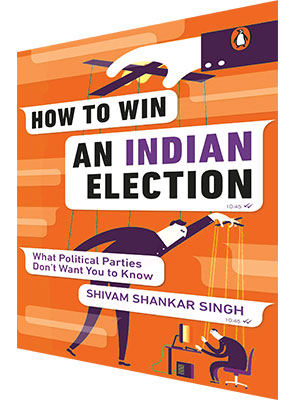Internet age politics: How to win an Indian election
 How to win an Indian election: What political parties don’t want you to know – Shivam Shankar Singh
How to win an Indian election: What political parties don’t want you to know – Shivam Shankar Singh
Penguin/Ebury press Rs.240, Pages 201
Shivam Shankar Singh’s How to Win an Indian Election is an insider’s candid account of how political parties leverage voters’ data and digital technologies for political campaigning. Singh headed data analytics and campaigns for the Bharatiya Janata Party (BJP) for the Manipur and Tripura legislative assembly elections under the guidance of the party’s national general secretary, Ram Madhav.
By sharing insights as a former BJP data and campaign analyst, Singh spotlights the scale, impact and consequences of digital campaigning for micro-targeting voters. It helps one understand, to some extent, the role of data and new-age technology in the recently concluded General Election 2019 which the BJP won with a landslide majority.
How to win an Indian election starts with the aspiration of the author to do good for his country. He sees much value in returning to India from the US — under a LAMP fellowship — to serve the country by engaging with members of Parliament on policy matters. This phase in his life and career is marked by an “obsessive desire to learn about the Indian political landscape and the people who populate it”.
After the fellowship ended, Singh joined the Indian Political Action Committee (IPAC), a company run by political strategist Prashant Kishor who had masterminded Narendra Modi’s prime ministerial campaign in 2014. Kishor backs campaigns that have a leading face. He believes this approach connects with the public and is more marketable, especially in a country where citizens yearn to follow a supreme leader. In 2014 India had grown tired of Congress nepotism and corruption. This made it easier for Modi and his team to present the persona of a strong leader for the country. Singh learned much under Kishor’s leadership before moving to work directly for the BJP under Madhav’s guidance.
Comparing politics to entrepreneurship, Singh says that in the absence of data and privacy regulations in India, political parties easily access and play around with personal data of social media users — all without users’ knowledge, let alone permission. Through personal anecdotes, Singh discloses how data analysts, supported by sophisticated technology, assist political parties to reach their audiences, map their identities, monetise their emotions, and capture their votes.
According to the author, in many large Indian states, the caste and religion of over 70 percent of the people can be determined by analysing their names, which are publicly available on electoral rolls. Based on this and other information gathered by them, political parties use fake news and propaganda on social media to shape — or rather manipulate — voters’ minds through targeted profiling.
For those who’ve read Swati Chaturvedi’s I Am a Troll, the revelations in How to Win an Indian Election won’t come as a surprise, especially since Singh doesn’t write much about organised disinformation or misinformation or the source of it. The book does, however, reveal the functioning of BJP’s data operations — rather data grabbing — and how mapping the electorate on the basis of religion, caste, geography, needs and priorities helps to predict and influence electoral behaviour. It also simplifies the process of turning a leader into a demigod through effective campaigning, both online and offline.
A key requirement for such campaigning is human resources. And the BJP, in particular, has no dearth of enthusiastic techies ready to serve the nation by serving this political party — Singh an example himself. Then there are lakhs of volunteers or karyakartas ready to help out the party with almost anything, from distributing pamphlets and carrying out surveys to conducting pulse checks to profiling families in constituencies — free-of-charge.
Bucketing of people on the basis of religion and caste comes up repeatedly in Singh’s book. Bucketing is extremely crucial when a large segment is undecided. These are the votes waiting to be swung in favour of campaigning political parties. In Singh’s book, this undecided group is presented as credulous and, thus, susceptible to political fake messaging.
The author’s personal and simple writing style without any jargon makes it an engaging read, and easy for a reader to understand election war rooms and strategy planning. Singh draws on his experiences as a party volunteer, LAMP fellow and political campaign consultant in several states. He frankly discusses how voter buying, targeted advertising, fear mongering, infusing victimisation and use of violence are common electoral tactics used to harvest votes.
Interestingly, it was for these reasons that Singh became disillusioned with this mammoth party and resigned from the BJP in 2018. While the book does not deep dive into these issues, it encourages politically-inclined youth and first-time voters to think and analyse the information that media and political parties are feeding them. “It is extremely important for the nation that educated people who want to do something positive for the country enter politics, but it is also extremely important that they know what they are getting into,” he writes.
Leaving the readers with some hope in a country where political cleansing looks like a distant dream, Singh warns that honest politicians will continue to struggle when competing with the power and money of dishonest groups. This prompts many with the passion and skills to drive policies to stay clear of politics and choose other careers.
However, those that do enter politics and manage to stick around will eventually steer the political discourse in this country, he writes. India can become a pluralistic and inclusive society, or it could become an intolerant conflicts-prone society.
For new entrants into Indian politics, Singh offers useful advice. When deciding which party to work for, they must consciously decide on throwing in their lot with those who offend them the least.
Udita Chaturvedi (The Book Review, December 2019)
Also read: Transnational fantasy: Gun Island















Add comment